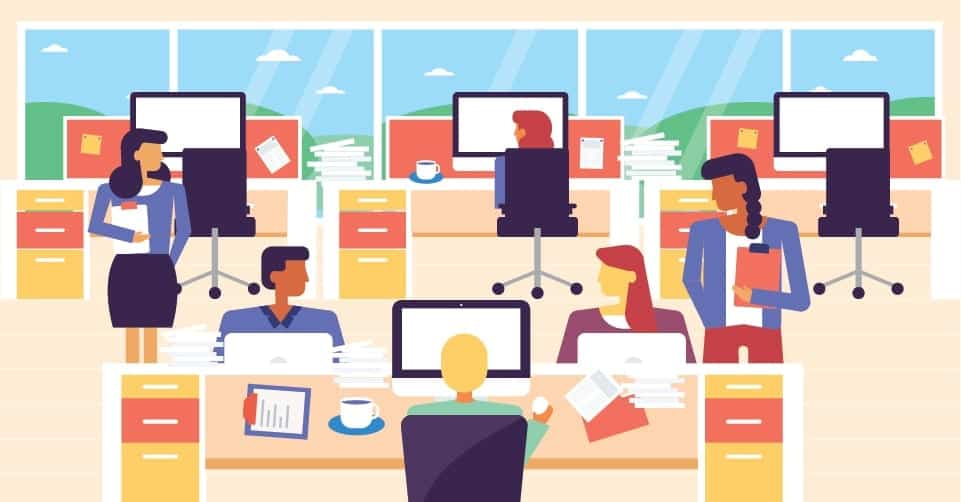Many factors contribute to a person’s stress level or how committed he or she feels to a job. But one thing’s clear: Bad office design doesn’t help. In one survey, 60 percent of cubicle workers and nearly half of workers in open-plan offices reported feeling frustrated about not being able to make a phone call or have a conversation without being overheard by co-workers. Workers also cited frustration about lack of space and visual privacy, bad air quality, unsatisfactory temperatures and light levels, and noise distractions.
On the flip side, research indicates good design may contribute to a more innovative workplace. The architectural firm Gensler surveyed 4,000 office workers and found that employees were more likely to rate companies with better designed, more functional workplaces as innovative. Want to ensure your office design boosts employee engagement and innovation? Keep reading to learn how to reinvent your office layout.

Ask your team
Your employees are the experts on the best working conditions for them, and it’s important to ask. Make sure the way you investigate boosts trust and builds relationships instead of breeding fear and distrust. Person-to-person conversations usually work better than mandatory email surveys. Want your team to really open up? Talk to them one on one, then provide several ways to connect about frustrations and ideas for better office layout. Consider devoting an email that receives concerns about office design, create a virtual suggestion box, or establish office hours for design-related conversations.
Be on brand
Your office design is not only functional; it’s a communication tool that sends a message to your clients about what to expect from your brand. And it’s a powerful way to instill your company’s culture in your employees. Resist the temptation to be bland, and think about unique ways your office can reflect your brand. Treadmill desks may not be the way to go if your industry is formal. However, if you run a fitness company, pedal desks and an on-site gym make sense. Likewise, an indoor veggie garden or organic cafeteria would go a long way in communicating a health-related company’s values to clients and employees.
Offer options and autonomy
Different workstations work well for different tasks. Quiet rooms are best for phone conversations and tasks that require focus. Collaborative areas are ideal for group work. Café spaces work well for socializing with colleagues or clients. In Gensler’s survey, the most innovative employees spent less time at their desks and more time collaborating and socializing in conference rooms, open meeting areas, and café spaces. Executives and managers in many industries have a choice of where to work, and Gensler advises empowering all employees with autonomy to move to different workspaces as needed. To do this, you’ll need to offer a mixture of private spaces and collaborative areas.
Prioritize ergonomics
Musculoskeletal issues are painful and expensive for employees and companies. Invest in theirsafety and comfort with ergonomic work stations, and be sure to provide employees with space and permission to get up and move around frequently. Also make sure employees have a comfortable place to take breaks, which can dramatically increase people’s ability to focus. Your investment in ergonomics may translate to fewer workers compensation claims and less employee absenteeism.
Provide optimal lighting
Natural sunlight is ideal for health and productivity. Workers in offices with windows sleep an average of 46 more minutes a night, according to a Northwestern study. They also perform 10 to 25 percent better on tests of mental function and memory recall. If your office lacks natural lighting from windows or skylights, put extra effort into providing sufficient lighting. High-temperature lighting is bluish, similar to sunlight. It enhances alertness, and usually works best in employee workspaces and collaboration areas. Lower-temperature lighting appears red or yellowish, similar to firelight. It makes people feel calm, and may work best in meeting rooms. Outdoors, the quality of sunlight changes throughout the day from high temperature to low temperature. Mimicking that rhythm indoors with a circadian lighting system may improve worker’s health and productivity.
Don’t discount décor
The color of a room can affect how its occupants feel. White and beige make people feel sad. Green and blue are soothing. Certain shades of orange and yellow are welcoming. Red can be good for productivity, or it can be threatening. Patterns, such as stripes and checks, may be distracting and cause headaches. When it comes to décor, nature is powerful. Workers who sit in desks near windows looking out on greenery miss fewer days of work and have reduced mental fatigue and improved productivity. Adding indoor plants to a workplace can boost productivity by 15 percent, according to research from Exeter University.
Experiment and be flexible
Office design should be an open-ended discussion rather than a short-term project. Modular workstations may be the way to go because they allow greater future flexibility than traditional office furniture. Devote a portion of staff meetings to checking in with employees about whether the office layout is functional, and leave your door open for conversations and complaints. It’s okay to rethink office design or make more changes if employees aren’t happy.
Conclusion
Your company, workplace, and employees are unique. Capitalize on what your space has to offer, whether it’s natural lighting or a large common area. Incorporate your brand into your design, get frequent input from your employees, and make changes as needed. With this approach, you’ll ensure your office layout helps your employees feel inspired, productive, and engaged rather than stressed out and frustrated.
Embed this on your website:
<p><br /><br /><a href='https://www.cubicleconcepts.com/blog/office-layout-dos-and-donts'> <img src='https://www.cubicleconcepts.com/images/cc/office-layout-dos-and-donts-for-a-productive-happy-workplace.jpg' alt='Office Layout Dos and Don'ts for a Productive Happy Workplace' width='600px' border='0' /></a><p><a href="https://www.cubicleconcepts.com/blog/office-layout-dos-and-donts">By Cubicle Concepts</a></p> </p>
Abby Quillen is the author of the novel The Garden of Dead Dreams and the editor of two anthologies. Her articles and essays have appeared in YES! Magazine and The Christian Science Monitor and on Common Dreams, Nation of Change, Reader Supported News, The Daily Good, Truthout, and Shareable. She lives in Eugene, Oregon, with her family. When she’s not writing, she grows vegetables and weeds, bikes and walks as much as she can, and jots down cute things her kids say. Visit her at abbyquillen.com.

